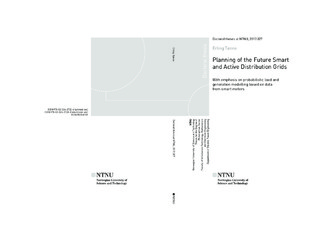| dc.contributor.advisor | Sand, Kjell | |
| dc.contributor.author | Tønne, Erling | |
| dc.date.accessioned | 2018-02-14T11:37:36Z | |
| dc.date.available | 2018-02-14T11:37:36Z | |
| dc.date.issued | 2017 | |
| dc.identifier.isbn | 978-82-326-2723-3 | |
| dc.identifier.issn | 1503-8181 | |
| dc.identifier.uri | http://hdl.handle.net/11250/2484598 | |
| dc.description.abstract | The energy sector is the largest source of greenhouse-gas emissions, and has therefore a crucial role to play in tackling the climate change. Every facets of the energy sector, and especially the power generation, needs to transform their carbon performance. Renewable energy sources (RES) are reducing the use of fossil fuels and energy efficiency is reducing the need for energy.
The amount of RES connected to the distribution grid is increasing. Generation from RES is unregulated and will vary in time according to e.g. solar radiation, wind speed or available water flow in the river.
The desire to be energy efficient encourage electricity consumers to buy and install high powered appliances that are being switched on and off frequently. The load is about to become more fluctuating with a certain stochastic character.
Extended use of control equipment, sensors and ICT in the distribution system will make it possible to connect more RES to the distribution grid, controlling the load flow in the grid and make the grid more robust regarding operational disturbances.
The DSO will get a lot more data from meters, sensors, control systems etc. that can be used to make better long term plans for grid development.
In this PhD work a new probabilistic method for load and generation modelling is proposed and compared with today’s deterministic method. Probabilistic network calculations (load flow) are performed with Monte Carlo simulations. The methods are tested against each other in a demo case consisting of a LV grid with seven different loads and a generator. The results from the test show that:
- Probabilistic calculations give better results than today’s deterministic calculations since probabilistic calculations give results presented as probability distribution functions instead of the deterministic (one single value) result.
- Power system planning based on probabilistic simulations will give better results – both technically and economically. The overinvestment in grid capacity will be reduced and the exploitation of the grid capacity will be higher.
Power system planning in the future should be performed with individual probabilistic loads and generation models and Monte Carlo simulations for load flow calculations. The new model described in this thesis should be adapted to existing software planning systems. | nb_NO |
| dc.language.iso | eng | nb_NO |
| dc.publisher | NTNU | nb_NO |
| dc.relation.ispartofseries | Doctoral theses at NTNU;2017:327 | |
| dc.title | Planning of the Future Smart and Active Distribution Grids: With emphasis on probabilistic load and generation modelling based on data from smart meters | nb_NO |
| dc.type | Doctoral thesis | nb_NO |
| dc.subject.nsi | VDP::Technology: 500::Electrotechnical disciplines: 540::Electrical power engineering: 542 | nb_NO |
| dc.description.localcode | Digital fulltext not available | nb_NO |
